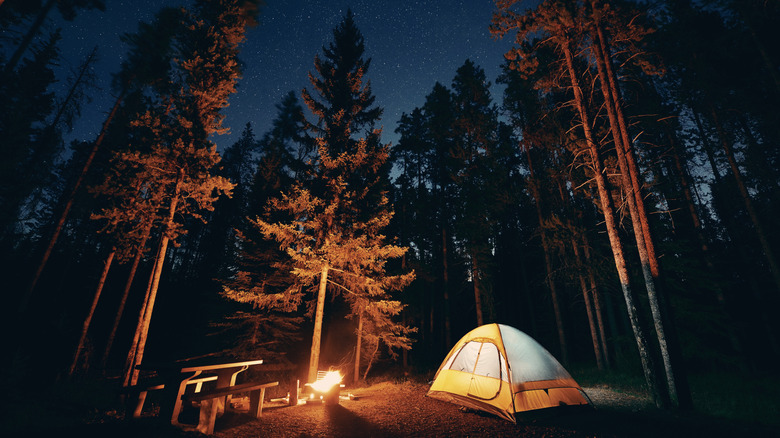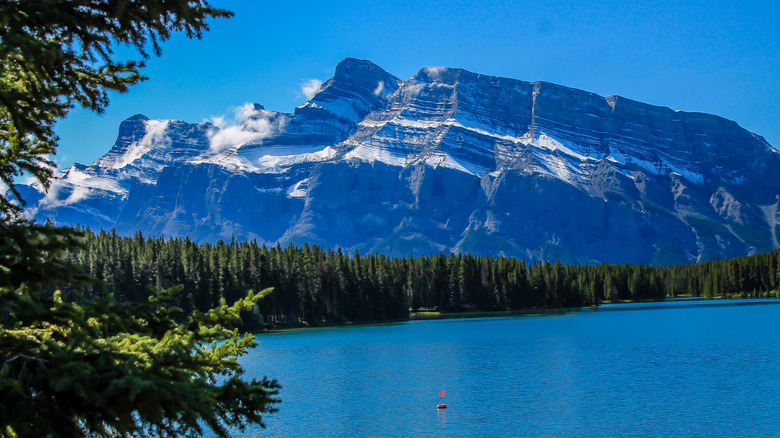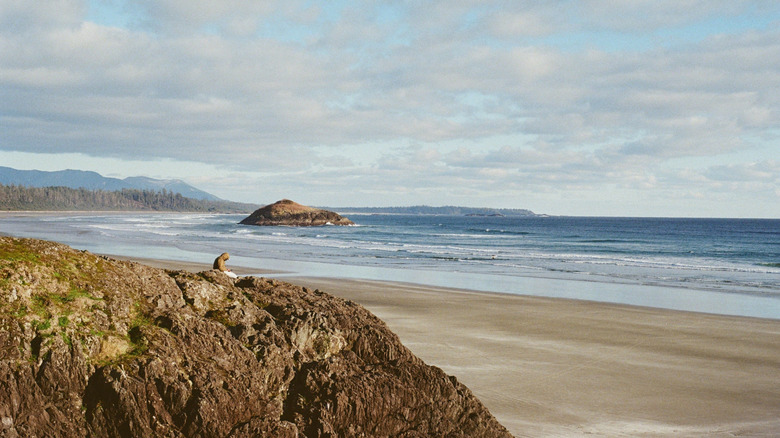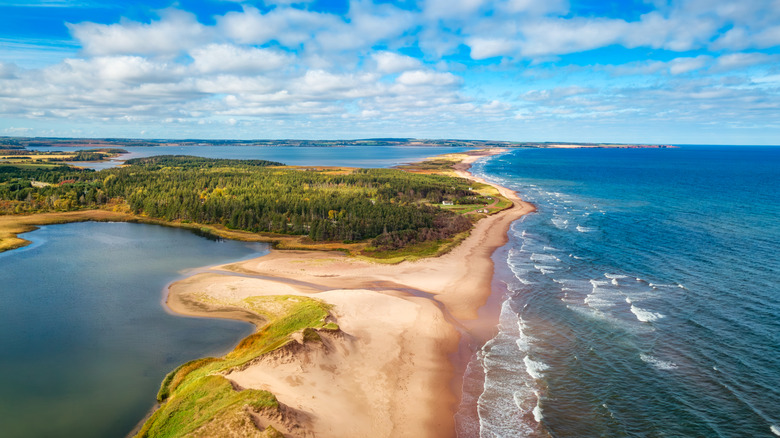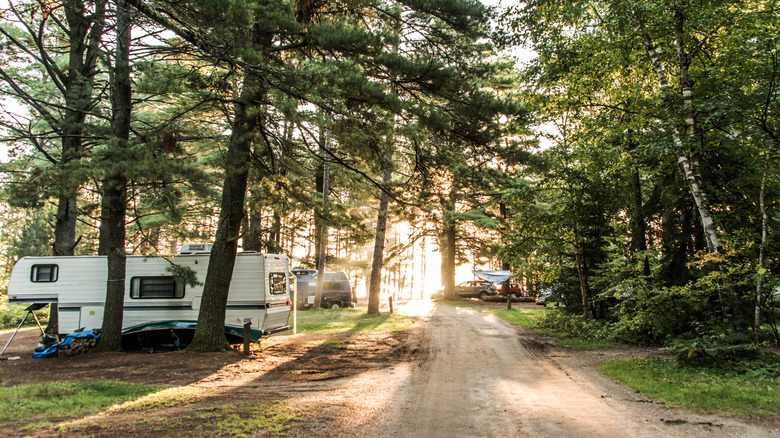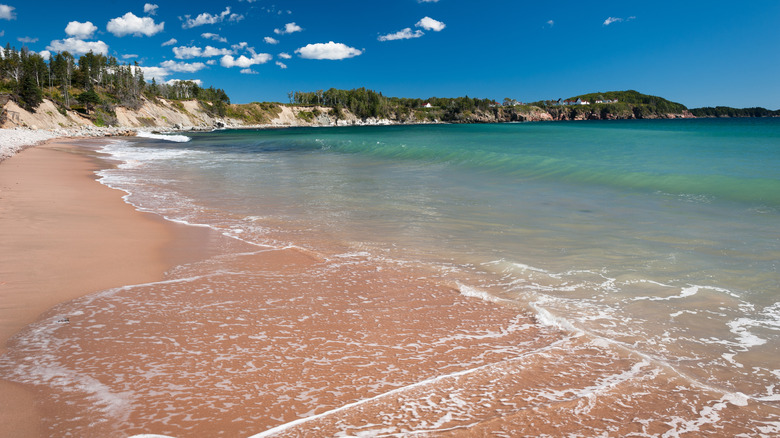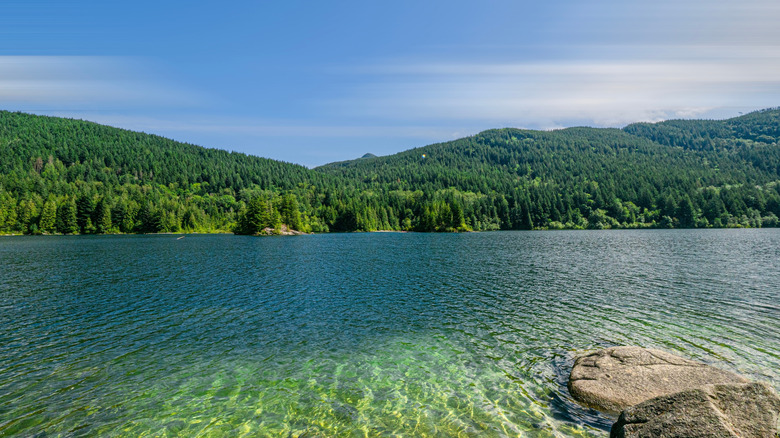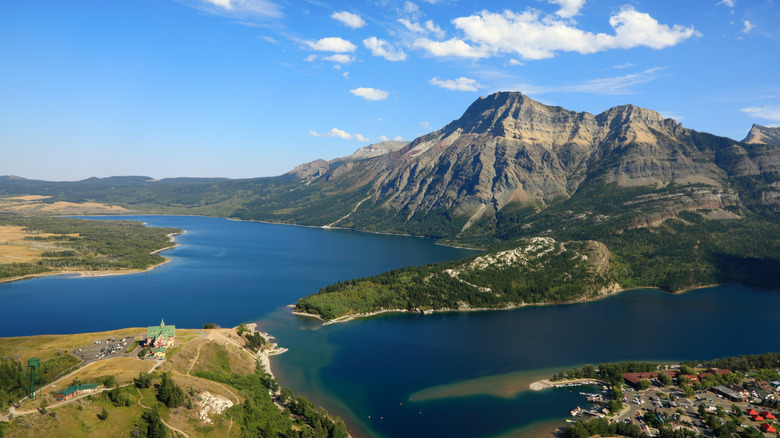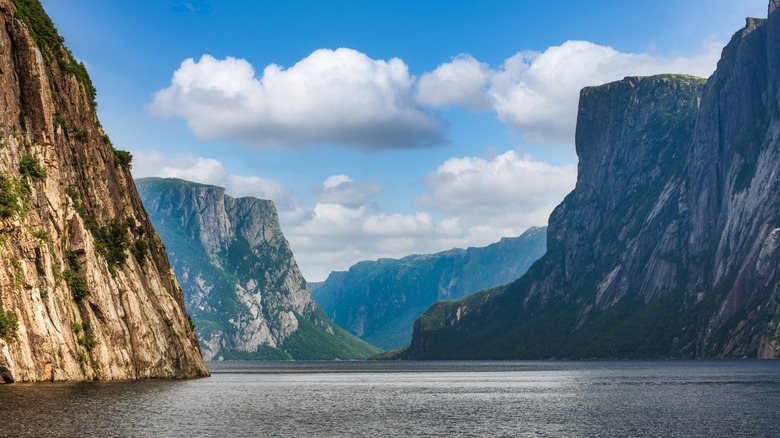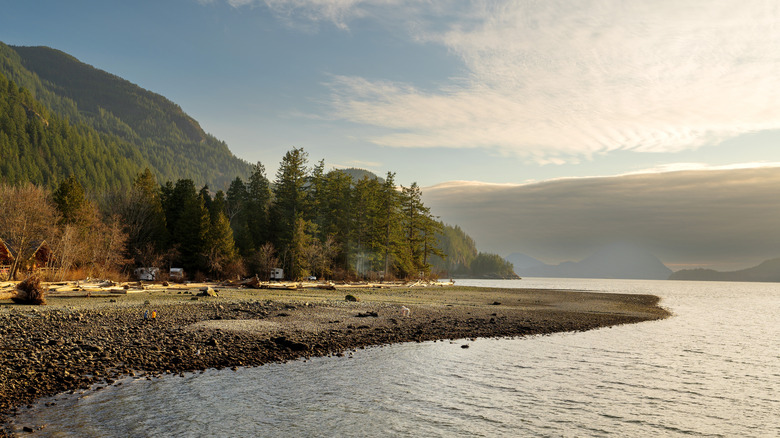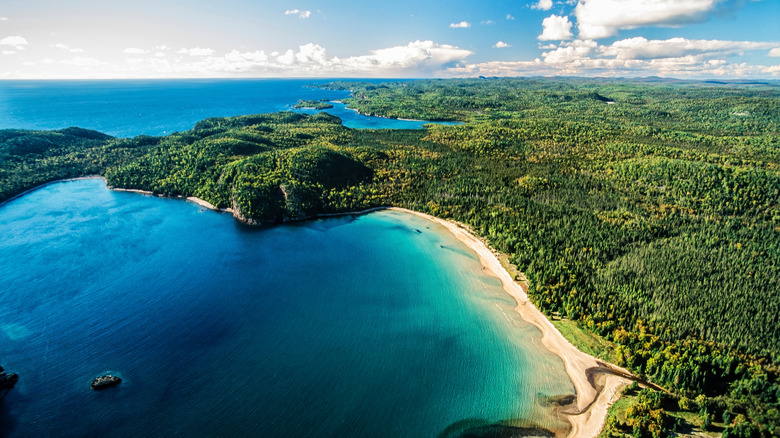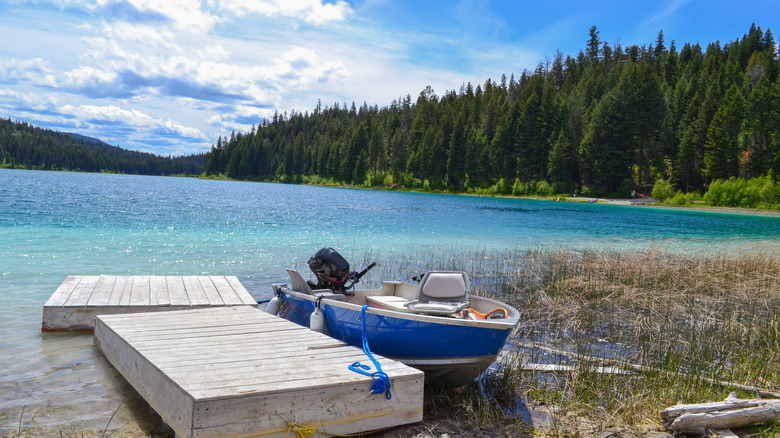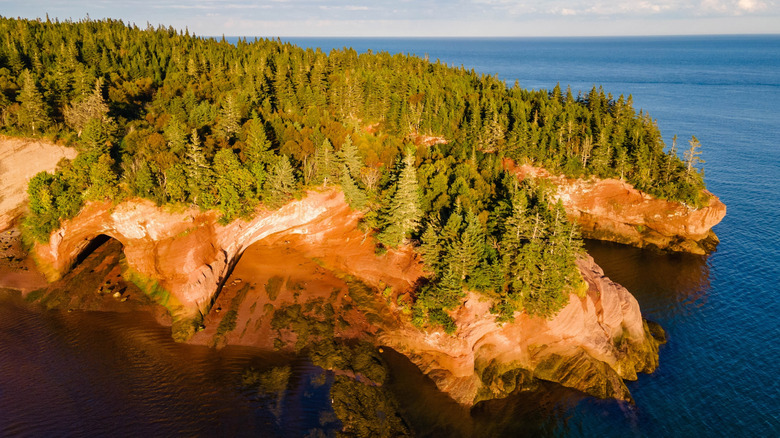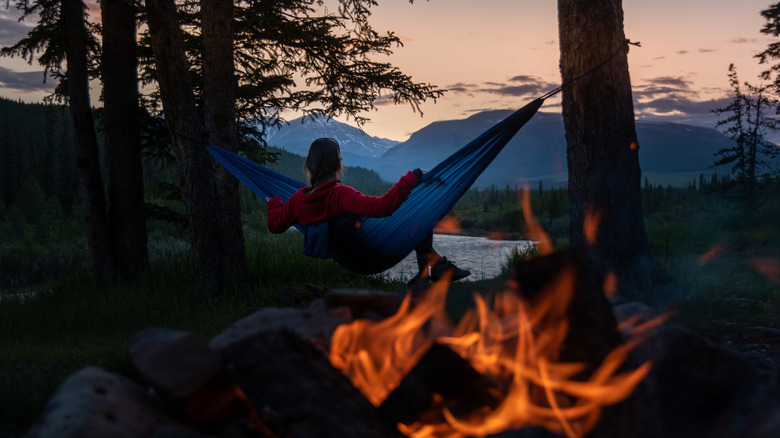The Most Scenic Campgrounds In Canada Are Tucked Into Parks, Islands, And Storybook Towns
Boasting the longest coastline in the world with remarkable beaches, sweeping mountain ranges, ancient forests, and wildlife that ranges from moose to whales, Canada is made for camping. Here, pitching a tent or parking an RV is never just about where you sleep: it's about stepping into some of the most remarkable landscapes on Earth. What makes Canada's camping culture unique is its variety. On one coast, you might fall asleep beside the roar of the Pacific; on the other, wake to red sandstone cliffs and the sound of the Atlantic tide. Inland, lakes stretch to the horizon, framed by boreal forest or craggy peaks, while in the North, vast skies shimmer with the northern lights.
Some sites are easy to reach, offering hot showers, playgrounds, access to surrounding towns, and evening ranger talks, making them perfect for families. Others take a little more effort — perhaps a long, winding drive through mountain passes, a journey north to the shores of Lake Superior, or a road trip along the Cabot Trail — but the reward is solitude, scenery, and a full immersion into the incredible surroundings. This list brings together Canada's most scenic campgrounds, chosen for their settings, facilities, and the unforgettable experiences they offer.
Two Jack Lake Campground, Banff National Park, Alberta
Just 15 minutes from the town of Banff, Alberta, Two Jack Lake Campground offers one of the most scenic bases in the Canadian Rockies. Tucked along the Lake Minnewanka Scenic Drive, it delivers exactly the kind of view travelers picture when they think of Banff, famous for its majestic mountains and vibrant blue waters, with the dramatic rise of Mount Rundle in the distance. Two Jack isn't a single campground but a pair of distinct options, each with its own character. Two Jack Main, open from mid-June to September 1, is the larger site with hundreds of vehicle-accessible pitches. Just down the road, Two Jack Lakeside is the more coveted spot, open from late May to early October, with a mix of walk-in sites tucked close to the water and vehicle-accessible sites for tents and small RVs.
Across both areas, facilities are straightforward but well-kept, with drinking water and modern washrooms. Whether you want the sociable bustle of Main or the quieter, more scenic shoreside atmosphere of Lakeside, Two Jack caters to a wide range of campers while keeping that unbeatable setting front and centre. Spend the day paddling across the lake or exploring Banff's numerous scenic hiking trails, then return to your campsite for starlit skies reflected in the water. Bliss.
Green Point Campground, Pacific Rim National Park Reserve, British Columbia
On Vancouver Island's west coast, Green Point Campground is where towering rainforest meets the roar of the Pacific. Perched above Long Beach, a sweeping stretch of sand with waves made for surfing, it's the only vehicle-accessible campground in Pacific Rim National Park Reserve, just 20 minutes from the laid-back surf town of Tofino. Here, coffee shops, galleries, and the now-legendary Tacofino food truck (so beloved it grew into a chain of restaurants across Vancouver) add flavor to British Columbia's coastal vibe. Reaching Green Point is part of the adventure. From Nanaimo, the two-and-a-half-hour drive twists through mountain passes and dense forest, with a memorable stop at Macmillan Park's Cathedral Grove, where centuries-old Douglas firs tower.
By the time you arrive, Green Point feels like another world entirely. The campground has 94 drive-in sites for tents and RVs and 20 walk-in sites tucked among the trees, each with a fire pit and picnic table. Facilities include drinking water, flush toilets, and showers, while trails lead straight from camp down to the beach. Evenings often end with a campfire, salt air mingling with woodsmoke as the light fades over the Pacific. Open from May 1 to mid-October, Green Point strikes a balance between rugged coastal drama and the comforts of a well-run campground. You can spend the day surfing or storm watching, beachcombing for shells and driftwood, or simply walking the vast expanse of Long Beach. Come nightfall, it's all about stargazing and falling asleep to the steady pulse of waves.
Cavendish Campground, Prince Edward Island National Park, Prince Edward Island
On Prince Edward Island, a by-the-sea storybook destination with artsy vibes, Cavendish Campground combines sweeping coastal scenery with a dash of literary charm. Just beyond the dunes lies Green Gables Heritage Place, the former home of Lucy Maud Montgomery, author of the iconic novel Anne of Green Gables, while steps from camp, you'll find red sand beaches washed by the Gulf of St. Lawrence. A place where natural beauty and nostalgia come together, the campground is about 45 minutes by car from Charlottetown or the Confederation Bridge crossing, making it an easy and picturesque stop on any road trip across the province.
The campground itself has over 200 sites, a mix of unserviced and serviced pitches for tents and RVs. Facilities include modern washrooms with hot showers, kitchen shelters, a laundromat, and even a playground. Walking and cycling trails connect the camp to nearby attractions. Open from early June to late September, Cavendish offers both comfort and atmosphere. Here, you can spend the morning on the sand, cycle into town for lobster rolls, then return to your tent for a sunset that feels lifted from the pages of a novel.
Lake of Two Rivers Campground, Algonquin Provincial Park, Ontario
In the heart of Algonquin Provincial Park, Lake of Two Rivers Campground offers a classic Ontario camping experience: a wide sandy beach, calm waters perfect for swimming, and trails that wind through acres of pristine, abundant forest. Despite its wilderness feel, the campground is right off Highway 60, about a three-and-a-half-hour drive north of Toronto or three hours from Ottawa, making it one of the easiest ways to dip into Algonquin without heading deep into the backcountry.
The campground is spacious, with over 200 car-accessible sites and two comfort stations featuring showers, washrooms, and laundry facilities. The adjacent Lake of Two Rivers store rents bikes for those who want to explore further. Trails here range from short looped walks to full-day hikes, and the lake itself is a natural launch point for exploring Algonquin's impressive and expansive canoe routes. Open from early May to late October, the campground is just as appealing in autumn, when the forest turns red and gold. Here, you can grab an ice cream at the store, then spot a moose (if you're lucky!) browsing along the shoreline before dusk.
Broad Cove Campground, Cape Breton Highlands National Park, Nova Scotia
Broad Cove Campground sits on the infamous Cabot Trail, a unique artisan trail that winds its way through Cape Breton Island in Nova Scotia. The journey there, then, is half the experience, with the road meandering past cliffside lookouts, quiet coves, and storybook fishing villages that seem frozen in time. When you finally arrive, the reward is an oceanside campground where the Atlantic pounds against rugged headlands just beyond the dunes. It's one of the park's largest, with 202 car-accessible sites set among the trees offering both shelter and privacy.
Facilities are well equipped for longer stays: comfort stations with hot showers, fire pits, kitchen shelters, a playground, plus direct access to a sandy beach that warms enough for summer swimming. A bonus when you visit in summer is that rangers lead evening interpretive programs in July and August, sharing insights into local ecology and Acadian culture, while regular communal campfire events also take place on the beach. Open from mid-May to late October, Broad Cove is an ideal place to discover Cape Breton's wild charm — where days can be spent hiking or chasing waterfalls, and nights end with the crash of waves and a sky scattered with stars.
Hicks Lake Campground, Sasquatch Provincial Park, British Columbia
Set deep in Sasquatch Provincial Park in British Columbia, near Harrison Hot Springs, Hicks Lake Campground offers a peaceful escape framed by forested hills and crystal clear mountain water. It feels remote, yet it's only around a two-hour drive from the bustling city of Vancouver and features 72 car-accessible sites close to the lake's sandy shoreline — making it a favourite weekend retreat for Lower Mainland campers.
Facilities include pit toilets, water taps, and picnic areas, while the lake itself invites swimming and fishing, or canoeing out to one of its many small coves that can serve as your own private beach for the day. Fancy stretching your legs? The four-kilometre out-and-back Hicks Lake trail is perfect for exploring the surrounding area without straying far from camp. Open from April 1 through October 14, this campground's charm lies in its balance of seclusion and accessibility. It's quieter than the larger campgrounds at nearby Deer Lake, but just as beautiful — an easy-going, scenic spot where you can take a morning dip, paddle out across calm waters, and return to a campfire under the trees.
Townsite Campground, Waterton Lakes National Park, Alberta
Few campgrounds combine wilderness and village charm quite like Townsite in Alberta's Waterton Lakes National Park. Perched on the shores of Upper Waterton Lake, it sits at the point where the prairies meet the Rockies, with sweeping views of the surrounding peaks and the convenience of a mountain town just steps away. A grand total of 246 sites (a mix of car accessible, walk-in, serviced, and unserviced) means there's space for every type of camper. While there are no fire pits here, the campground amenities are plentiful, including washrooms with flush toilets, hot showers, food storage lockers, and kitchen shelters with wood-burning stoves.
The sites themselves are open and breezy, with the lake just beyond: perfect for launching a canoe or simply soaking in the scenery. And if you feel like a break from cooking, that's no problem. The restaurants, cafés, and shops of Waterton village are a short stroll away, making this one of Canada's most sociable national park camping experiences. Operational from April 1 to mid-October, and open for the rest of the year with limited services, Townsite is a great base for hiking, with trails leading straight from the village into the backcountry. In fact, it's a perfect mix of scenery and convenience: you can grab a coffee in town in the morning, then be high on a ridge trail by afternoon.
Berry Hill Campground, Gros Morne National Park, Newfoundland and Labrador
Newfoundland and Labrador, named Canada's most affordable province for 2025, is home to Gros Morne National Park, a UNESCO World Heritage Site — and Berry Hill Campground is perfectly placed for exploring the dramatic landscape. Surrounded by cliffs, fjords, and forest, it's also close to the Tablelands: an otherworldly expanse of exposed mantle rock where the Earth's crust has been laid bare. From June to September, Parks Canada guides lead two-hour walks across this surreal landscape, tracing glacially carved valleys and explaining the geological discoveries that changed how we understand the planet. Prefer to explore on your own? The Tablelands Trail is an easy 4 km walk with sweeping views and options to branch off into hidden canyons or, for the adventurous, climb higher for one of the most remarkable hikes in North America.
The campground itself offers 69 forested vehicle-accessible sites and a handful of rustic cabin rentals, with shower facilities, laundry, and kitchen shelters to make longer stays comfortable. Three trails leading directly from camp invite you to wander through forest and lowlands, while the charming towns of Rocky Harbour and Norris Point are just a short drive away, with restaurants, shops, and activities adding a lively counterpoint to the park's wilderness. Open from May to September, Berry Hill is a rare chance to immerse yourself in a place so geologically unique it's recognised by UNESCO, without giving up the simple pleasures of a well-run campground.
Porteau Cove Campground, Howe Sound, British Columbia
Set right on the waterfront of Howe Sound along the scenic Sea-to-Sky Highway, Porteau Cove is one of the few campgrounds in British Columbia where you can fall asleep to the sound of the ocean, thanks to its waterfront campsites. Just a 40-minute drive from Vancouver, and an hour from one of Canada's best ski towns (that is just as thrilling in summer), it combines dramatic coastal scenery with easy access, making it a coveted spot for weekend campers. Open year-round, this small but perfectly formed campground has 44 sites — 16 of them walk-in, albeit a short walk — along with two cabin rentals for those who prefer four walls around them.
Amenities include the usual with pit and flush toilets, hot showers, and picnic tables, and also the slightly more unique. The park features artificial reefs and sunken ships just offshore for scuba divers to explore, while the pier is a favorite for fishing, sunset views, and spotting the abundant marine life that call this slice of Canada home. With the mountains at your back and uninterrupted ocean views so close to the city, it's easy to see why Porteau Cove fills so quickly in summer — reservations are essential during peak season.
Hattie Cove Campground, Pukaskwa National Park, Ontario
Lake Superior doesn't feel like a lake so much as an inland ocean, and at Hattie Cove, you're camped right on its edge. This sheltered bay near the town of Marathon is the threshold to Pukaskwa, Ontario's only wilderness national park, and it delivers a heady mix of remoteness and refuge. There are 67 vehicle-accessible sites, a mix of unserviced and electricity-serviced pitches, all set among dense boreal forest. Facilities go beyond the basics: along with hot showers and flush toilets, you'll find kitchen shelters, dishwashing stations, a canoe launch, and a camp store for supplies.
Visit in summer and you'll discover that Parks Canada interpreters lead guided walks and talks that connect visitors to Anishinaabe culture and the park's ecosystems — whether it's learning how people have lived with Superior for generations, or spotting rare plant life that grows nowhere else in Ontario. When it comes to hiking, visitors are spoiled for choice, from gentle woodland trails that peel away from the campground itself to the ruggedly epic Coastal Hiking Trail and the White River Suspension Bridge Trail, which culminates in — you guessed it — the White River Suspension Bridge, a lofty walkway hanging above the thunder of Chigamiwinigum Falls. Open from mid-May to mid-October, Hattie Cove captures the essence of Canada's north shore with vast skies, cobalt waters, and a wilderness just waiting to be explored.
Kentucky-Alleyne Provincial Park Campgrounds, British Columbia
High in British Columbia's interior, a 30-minute drive from Merritt, Kentucky-Alleyne Provincial Park is a study in contrasts: rolling golden hills and a dry grassland climate set against twin lakes so clear and turquoise they look almost alpine. The park has 74 vehicle-accessible sites spread across three areas, each with its own character. Along Kentucky Lake, the sites are sunny and spacious, with gravel pads, picnic tables, and fire rings. Most are right on the water, offering uninterrupted lake views from your tent or trailer. West Pond is smaller, with a handful of pull-through sites perched on a narrow terrace above the water — easy to access, but with the feel of a hidden nook.
Over at Alleyne Lake, the road winds past a variety of sites. Some are tucked right on the shoreline, while others are set back with broad views across the water and surrounding grasslands. There is also a quiet loop shaded by Douglas firs for those who prefer a little more cover. Camping is generally available from May through September, with Kentucky Lake closing after Thanksgiving while West Pond and Alleyne remain open year-round (though without services in winter). With its turquoise waters, sun-soaked hillsides, and peaceful, uncrowded feel, Kentucky-Alleyne proves that British Columbia's beauty stretches well beyond the coast and mountains.
Chignecto Campground, Fundy National Park, New Brunswick
Famous for the world's highest tides, New Brunswick's Fundy National Park offers a camping experience shaped by its dramatic coastlines and thick Acadian forest. Chignecto Campground, the park's largest, sits on a wooded hillside slightly further inland than the other campgrounds, meaning it avoids much of the fog that drifts in from the bay. The result is a sheltered, comfortable base that's especially appealing for families looking to explore without worrying about damp, chilly nights. With 263 sites, Chignecto offers space and variety, providing unserviced and serviced pitches, along with amenities like washrooms with showers, laundry facilities, and kitchen shelters. The elevated setting keeps sites cool and shaded in summer.
It's a place where kids can safely explore on two wheels thanks to the on-site family biking trail,or work off some energy at the two camp playgrounds, while adults will appreciate the easy access to trails that lead to tidal flats, waterfalls, and lookout points. Guided walks reveal the bay's famous tides, which rise and fall by up to 12 metres twice each day. Open from mid-May to mid-October, Chignecto offers the perfect base to discover the wonder of Fundy's wild landscapes.
Methodology
This list was created to highlight the remarkable diversity of camping in Canada, focusing on scenery as a key criterion: each site needed to offer a distinctive sense of place, whether from sweeping mountain views, fascinating natural history, or cultural significance. Practical details such as site numbers, facilities, and opening seasons come directly from official sources, including Parks Canada, BC Parks, Ontario Parks, and provincial tourism boards, ensuring the information is accurate and up to date. To that foundation, I've added my own perspective. After living in Canada for nine years and camping widely across multiple provinces, I bring firsthand knowledge that helps shape the list beyond facts and figures. The final selection isn't ranked but curated to reflect both regional variety and camping styles: from large, well-serviced family campgrounds with ranger talks and playgrounds to quieter, more remote sites where the draw is solitude and scenery. Together, they capture the many ways travelers can connect with the Canadian outdoors, each one offering its own memorable take on the country's landscapes.
